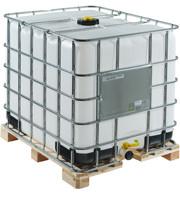by Rüdiger Pansch, rospatt osten pross
And here we are again with more recent decisions on the bulk container paradox (see Brian’s post Bottling the After-Market; Max’s post on Patent Law and Philosophy; my post on Entitative Elements of Bulk Containers).
Imagine you have an IBC (Intermediate Bulk Container), just as this one:
Now, you open the upper crossbars, take out the original inner plastic bottle and re-place it with your own plastic bottle (so called “rebottling”). Do you make a new IBC, or do you just repair the old product? Do you commit a patent infringement by making a new embodiment, or do you just use the old embodiment in respect to which the patentee’s rights remain exhausted?
In two recent judgments of 28 July 2011 (docket nos. 6 U 3411/10 and 6 U 3412/10), the Munich Court of Appeal denied patent infringement. Just as in the first instance, replacement of the bottle was considered a repair of the original IBC and not a making of a new IBC.
The two judgments are applying assessment criteria as laid down in three decisions of the Federal Supreme Court on different technical items (Bundesgerichtshof: “Flügelradzähler” [2004] GRUR 758; “Laufkranz” [2006] GRUR 837; “Pipettensystem” [2007] GRUR 769). Which parts embody the entitative elements of the invention? Which parts are improved by the invention? Is the bottle nothing more than a mere object of the improved cage?
The judgments explicitly dissent from the judgment of the English High Court of Jus-tice, Court of Appeal, [2011] EWCA Civ 303 in re. Schütz vs Werit of 29 March 2011. The Court of Appeal found for patent infringement overruling the decision of the London High Court of Justice, [2010] EWHC 660 (pat) of 31 March 2010.
In both Munich judgments, leave to a second appeal was granted. Both proceedings are now pending at the Federal Supreme Court. We will keep you updated.
________________________
To make sure you do not miss out on regular updates from the Kluwer Patent Blog, please subscribe here.



